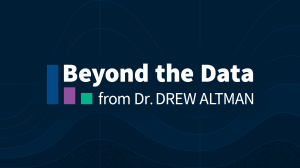Decoding the HHS Reorganization
Having reorganized both nonprofit and public sector organizations, these are a few reflections on Secretary Robert F. Kennedy Jr.’s restructuring of the Department of Health and Human Services (HHS). I know the department pretty well and worked there early in my career.
First, HHS is no stranger to reorganization. HHS itself was born from a reorganization when education was split off from the Department of Health, Education, and Welfare, and became a separate cabinet agency. CMS too was a product of a significant reorganization bringing together previously separate agencies and putting Medicare and Medicaid under one roof, later to be joined by the Affordable Care Act (ACA). (Medicare had been run by the Social Security Administration and Medicaid by something called the Social and Rehabilitation Service). All that happened under Secretary Joe Califano, who was later fired by President Jimmy Carter as part of a wider cabinet purge for taking on tobacco companies too aggressively. Califano was possibly the last HHS Secretary with as independent an agenda as Secretary Kennedy has today, albeit a very different one.
Prior reorganizations at HHS were mostly dedicated to building new capabilities and the federal role in health. The exception was the Bush era name change from Health Care Financing Administration to CMS partly intended to signal a less aggressive purchasing and regulatory role. Secretary Kennedy’s reorganization breaks sharply with the past. It represents an effort to cut back the size and role of the department as part of broader administration-wide efforts to reduce the role of the federal government in health.
What is most significant about the reorganization is not the many ways in which it moves boxes around on the organization chart, but the cuts in staffing levels that go along with that–from 82,000 to 62,000. No doubt HHS can get along with fewer staff in many areas or fewer regional offices, but cuts of that magnitude will have a profound effect on the scope and effectiveness of operations. It is admittedly difficult to determine from the outside how much staffing cuts are being driven by DOGE, the Secretary or both.
Some of the changes are directed at consolidating Public Health Service agencies into a new Administration for a Healthy America, including the Office of the Assistant Secretary for Health, the Health Resources and Services Administration, the Substance Abuse and Mental Health Services Administration, and others. All these agencies relate to health, but it isn’t at all clear how their restructuring with a name change will reduce chronic diseases and their causes such as obesity and diabetes, without new initiatives and substantive redirection. These may still be to come, but changing an organization chart does not change health outcomes. Secretary Kennedy also has non-mainstream views on addressing substance use which might materialize as part of the new agenda for the agency.
The reorganization does not appear to significantly touch HHS’s largest programs: Medicaid, Medicare, and the ACA. Action on those fronts will come mainly from Congress and the White House’s Office of Management and Budget. Major cuts in Medicaid and ACA coverage could do more to undermine the health (and income security) of all the populations served by the new Administration for a Healthy America than anything it could do. And, of course, CMS oversees these big benefits programs, and inside HHS, has always seen itself as the power player as a result. CMS has seldom played well with the smaller agencies the secretary has reorganized and has often dueled with other HHS agencies and White House staff, seeking a degree of independence. Several agencies in HHS have self-identities that they see as giving them at least some independence while still operating within the bounds of administration priorities: the Food and Drug Administration as both a regulatory and scientific agency; the Centers for Disease Control and Prevention as a scientific one; and CMS as a big purchaser and quasi-regulatory agency. This has sometimes created a tension both with secretaries and White House staff.
One of the things I learned in public office is that time in office is short, and prioritization is essential. Beyond cutting, Secretary Kennedy will eventually conclude he cannot change the entire bureaucracy and make it think like he does or pursue his priorities exactly as he wants it to, but he can set up new units to advance his priorities led by officials who agree with them. Keep an eye on those units. A few examples: the new Office of Vaccine Injury in CDC, or the new Assistant Secretary for Strategy. Some of these new units and the appointees who head them would appear to advance anti-science or non-mainstream agendas.
Finally, there are the offices and functions that are reportedly disappearing entirely, such as the Office of Infectious Diseases and HIV/AIDS Policy, or the Office of Minority Health, or the Administration for Community Living. All of these address equity issues. One conundrum: You cannot effectively address chronic illness in America without also addressing disparities and their underlying causes, even if you choose to no longer call that out explicitly.
At some point in the future, some Secretary appointed by a Democrat will be faced with a dilemma—how much to focus on the slog of rebuilding HHS agency by agency and position by position, versus how much to focus on a few policy priorities during what is also likely to be a short time in office. Now, there is likely no escaping the fact that she or he will have to do both. Rebuilding will require funding and Congressional action, even though, for the first time ever, eliminating tens of thousands of staff and whole agencies under the Trump administration has not.
